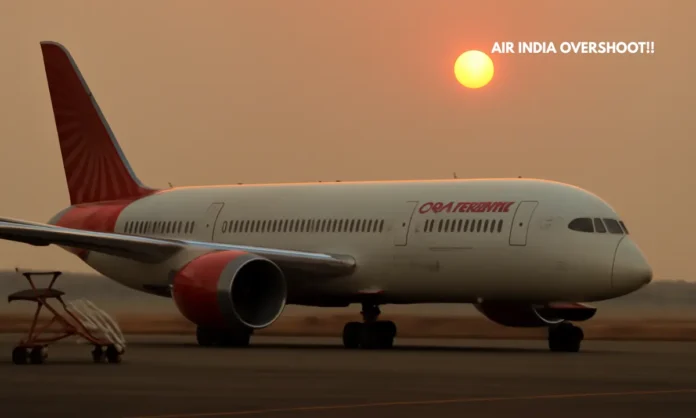Summary
- DGCA issued a warning to Air India following two long-haul flights exceeding flight-time limits.
- The airline’s Accountable Manager failed to ensure key operator-level compliance.
- Air India attributed the lapse to misinterpretation of a permission and pledged corrective action.
Setting the Scene: Hours Over the Limit
The DGCA warning to Air India arrived after a routine spot check revealed that two flights from Bangalore to London (AI-133) on May 16 and 17, 2025, each surpassed the maximum permitted flight time of 10 hours under the Civil Aviation Requirements (CAR). Essentially, the DGCA warning to Air India highlighted a breach of flight-time regulations intended to safeguard pilot fatigue and operational safety. At first glance, this appears procedural—but in aviation, such procedural oversights can carry serious consequences.
In parallel, the regulator noted that Air India’s appointed Accountable Manager failed to ensure compliance with operational provisions outlined in Annexure III of the CARs. The issuance of a formal notice signals the gravity with which the aviation watchdog treated these oversights, solidifying the DGCA warning to Air India as more than a mild reprimand—it is a clear call for immediate and sustained corrective measures.
Putting out @DGCAIndia Warning letter for all to know that this is bare minimum what regulatory body has done , Pilots operate at the behest of airline and in this case its @airindia , Pilots don't have authority to take decision for not to fly they are employees in the end , so… https://t.co/3gee57rash pic.twitter.com/B20Y9KqgaY
— Harsha chandwani (@harsha19chand) August 13, 2025
Root Causes Exposed and Regulatory Stakes
The events leading to the DGCA warning to Air India stemmed from that misreading of operational permissions granted amid border-related airspace restrictions. Air India, in its response to the regulator, claimed the overrun in flight-time was due to “a different interpretation of a permission” to mitigate airspace closures. That explanation, while plausible, did not satisfy the DGCA, which ultimately escalated the matter. Thus, the DGCA warning to Air India reflects not only procedural non-compliance but also a failure in internal interpretation and oversight systems.
Beyond that, the regulator’s issuance of a Show Cause Notice on June 20, 2025—under its Enforcement Policy and Procedures Manual—further solidifies the seriousness of the DGCA warning to Air India. When a Show Cause Notice precedes a warning letter, it typically means corrective steps must be accompanied by clear proof of root-cause analysis and remediation, or the airline may face penalties or further enforcement. The DGCA warning to Air India therefore opens the door to potential operational or financial sanctions, unless air India demonstrates robust corrective action.
What’s At Stake for Safety and Standards
Compliance in aviation isn’t optional. The DGCA warning to Air India underscores how critical it is for airlines to interpret and apply exemptions or permissions consistently and transparently. If one aircraft exceeds limits—even for well-intentioned reasons—that raises concerns about fatigue management, crew scheduling, and operational risk. The fact that the Accountable Manager was specifically faulted points to lapses in oversight responsibilities. After all, that role exists precisely to ensure that day-to-day operations align with regulatory frameworks.
Moreover, the DGCA warning to Air India may resonate across the sector, acting as a cautionary signal to other Indian carriers: regulatory permissions are not a loophole to stretch operational limits. Rather, such permissions must be tightly controlled, with clear approval protocols and documentation. That’s why the DGCA called for “utmost diligence” going forward—something every airline’s operational leadership must reflect and adopt.
Forward View: Repercussions and Recovery Path
Looking ahead, the DGCA warning to Air India sets a staging ground for corrective and preventive action. First, Air India must revise its rostering and flight-time monitoring systems to ensure no recurrence. Second, retraining or internal audits of the Accountable Manager’s office may be prudent. The DGCA will likely review follow-up documentation before dismissing the warning or closing the show-cause matter.
Simultaneously, the DGCA warning to Air India may influence stakeholder and public perception. Ensuring transparent communication about corrective measures will be key in rebuilding trust—among regulators, passengers, and government bodies. If Air India demonstrates prompt and lasting compliance, the incident may fade quickly. However, failure to act decisively may lead to escalated enforcement, reputational damage, or costs associated with more stringent oversight.
Final Perspective
In sum, the DGCA warning to Air India is a wake-up call that regulatory compliance in aviation is non-negotiable. While Air India’s explanation references border-related airspace issues, the regulator still flagged a procedural and oversight breach serious enough to warrant formal reprimand. The path forward hinges on whether Air India can translate this DGCA warning to Air India into tangible, sustained corrective action—and thereby reassure all stakeholders that flight-time control and aircraft safety are built into every operational decision.


